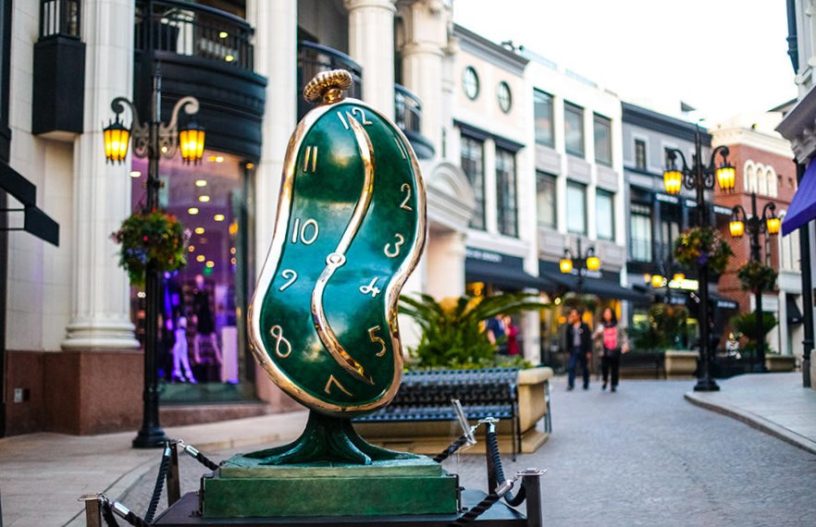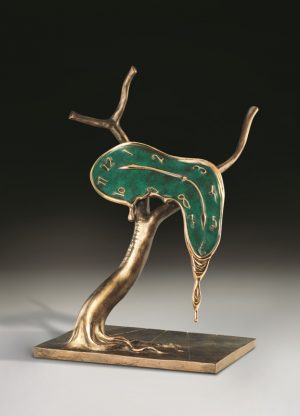
Dance of Time I on display in Beverly Hills, California
Chali-Rosso Art Gallery owner Susanna Strem talks why access to Dali is vital for Vancouver
It’s safe to say that surrealist Salvador Dali found the themes of time and memory incredibly fascinating. Clocks appear in much of his work, and this May, Vancouver is going to play host to one that’s seven feet tall. For Susanna Strem, owner of Chali-Rosso Art Gallery, the woman who coordinated with the Stratton Institute to bring Dance of Time I to Canada for the first time ever, it’s important to bring art into our daily lives and routines.
We caught up with Susanna to chat about the exhibit, what Dali means to kids, and why access to art is vital to society.
Arts Umbrella: How do you think Dali inspires kids who are discovering or practicing visual and other media arts?
Susanna Strem: [Dali] is out-of-the-box. He captures their attention and imagination. Dali’s work, such as the sculptures, and not just the clock, but all of his work, is about imagination and how to see the world from a different angle. It’s a reminder that there are many ways to see things, not just one. And this is absolutely for kids, and for anybody, really.

Triumphant Elephant, bronze, green patina, lost wax process, conceived 1975, cast 1984
AU: Why should kids be exposed to the historical masters?
SS: Dali’s life is embedded in European culture, especially in the French art world. To expose kids and people in Vancouver to this level of art, examining it and what it means, is important. Artists like Dali change the artistic lens for children and adults. Artists today would not create the same artwork if Dali wasn’t around. Every artwork that is created today is defined by the historical masters, including Dali and many others. It’s important that if a young artist is influenced by something, they know what it is. Today, it’s easy to find pictures online and to experience art through a computer. But it’s a whole different experience to see artwork [in person]. Our senses perceive a different aspect of the artwork.
AU: We live in a modern, connected world, which has made it feel much smaller. With an artist like Dali, who’s more distinctly from a place and time, viewers can really capture that essence. The youth of today have limitless access to view art on screen, but not always access to view it in person. Travelling exhibitions like Definitely Dali provide us with that access.
SS: There’s a huge difference seeing art in real life and not just in cyber space. The screen is two-dimensional and artwork is never two-dimensional, not even a painting. It has layers; it has texture; it has emotional effects. On the West Coast, we’re often not as exposed to European art as those on the East Coast. It’s possible to bring art here and not to get enclosed in our own art world only with what is created here. Art is all-inclusive. There’s room for both. [Dance of Time I] says a lot about our time, how we interpret time, how we perceive it; the ticks or tocks or dance of time is limitless, or even timeless.

Profile of Time, bronze, green patina, lost wax process, conceived 1977, cast 1984
AU: It’s a social commentary as much as it is a clock. It transcends time.
SS: In the 70s when [Dance of Time I] was conceived, it was a whole different era. There was no internet, no computer [not as they are now], but this piece talks to us still, and it will talk to us a hundred years from now. This is what makes something art. It’s more than just the piece itself. And this is the duality that Dali is all about. People will understand it if they see it. One has to be exposed to it, experience it. It cannot just be learned from a book. Arts Umbrella is laying the ground for this, laying the ground for kids [youth, and teens] to be perceptive to this culture. We’re on the same continuing line.
AU: At Arts Umbrella, we’re all about providing access to the arts. This exhibit is another layer of access: to Dali’s artwork and sculptures. Access that children and adults in the Lower Mainland might not otherwise get.
SS: The sculpture will be hard for people to just walk past. It evokes something. Art is absolutely integral in our lives, especially as we get less art in our daily routines. Art is able to help us understand ourselves.
Dance of Time I will be on display in downtown Vancouver at West Hastings and Hornby Street from May to September 2017. The unveiling will take place on May 6 at 2:00 p.m. While the sculpture is on public display, Chali-Rosso Art Gallery will be presenting the Definitely Dali project, with public donations and a percentage of sales going to Arts Umbrella.
The sculpture is on loan from The Stratton Institute, a non-profit organization dedicated to the promotion of culture and the arts, which possesses the world’s largest collection of Dali’s sculpture.
Dance of Time I was conceived in 1979 and cast in 1984. It exemplifies Dali’s controversial relationship with time and the importance he believed to be inherent in memory.
Chali-Rosso Art Gallery will be showing 100 additional Salvador Dali artworks, including 20 gallery-sized sculptures at their Howe Street location. The gallery was founded in 2005 and hosts a collection that is primarily focused on the modern masters, such as Pablo Picasso, Salvador Dali, Marc Chagall, Joan Miro, and Henri Matisse. They’ve also show works by Rembrandt van Rijn, Pierre-Auguste Renoir, Edgar Degas, Édouard Manet, Andy Warhol, and more. Chali-Rosso carries original artworks only, accompanied by documentation and certificates of authenticity.